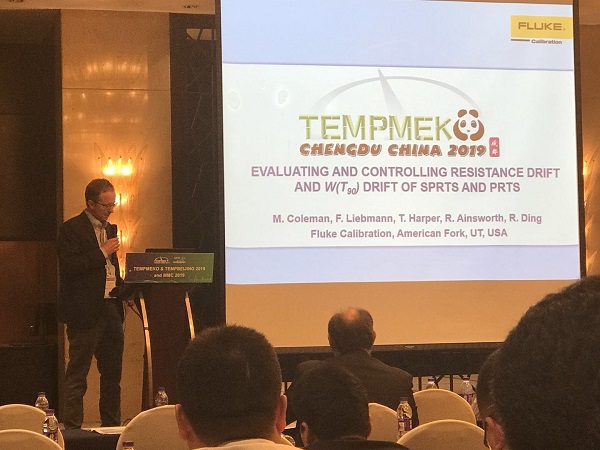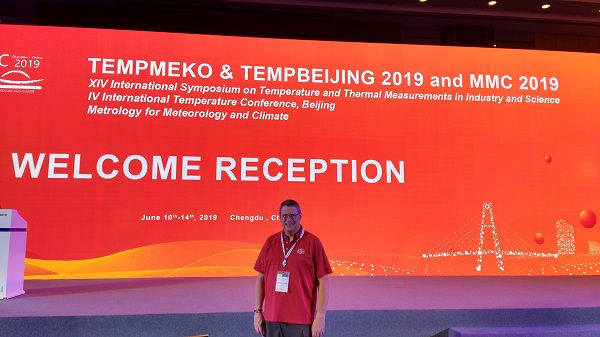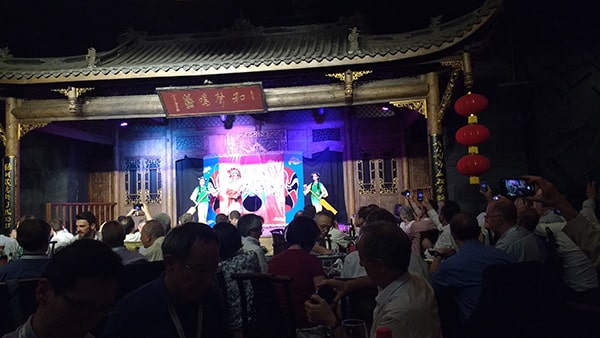- その他のフルークグループ:
- Fluke
- Fluke Biomedical
- Fluke Networks
- Fluke Process Instruments
Tempmeko 2019 Temperature Metrology Conference – Fluke Calibration’s Overview of the Conference
This summer a group of temperature calibration experts from Fluke Calibration attended the TEMPMEKO 2019 Temperature Metrology Conference held in Chengdu, China (https://www.tempmeko2019.cn/index.html) June 10 to 14. I wanted to take this opportunity to tell you about TEMPMEKO and to pass along the information we gathered at the conference to keep you informed on the latest developments in temperature calibration and metrology.
What is TEMPMEKO? TEMPMEKO is the world’s top-level temperature metrology conference and is held every three years. It is organized under the TC12 (Temperature and Thermal Measurements) committee of IMEKO (International Measurement Confederation, https://www.imeko.org/index.php). TEMPMEKO is attended mostly by scientists representing their countries’ temperature metrology and calibration programs so it is a great opportunity to meet and hear from NMI (National Metrology Institute) level experts who also serve on international metrology committees like the CCT (Consultative Committee for Temperature). TEMPMEKO is one of the conferences where they report their most recent research and discuss matters important to temperature measurement.
This year’s conference was especially notable due to the May 20, 2019 adoption of the Boltzmann constant as the new definition for the Kelvin, the SI unit for temperature (https://www.bipm.org/en/measurement-units/). This had been discussed and anticipated at TEMPMEKO conferences going back more than a decade, so everyone enjoyed seeing it finally happen and being able to talk about it.
Conference technical summary
The papers and talks presented at TEMPMEKO 2019 covered a wide variety of topics from improving metrology in meteorology (say that 10 times fast) to research into ways light can be used to measure temperature. Here is a list of the top 5 topics we learned about over the four days of presentations:
1. Impact of the kelvin redefinition
As we expected, the new kelvin redefinition was mentioned and addressed in several talks and presentations. The new definition doesn’t affect everyday temperature measurements and calibrations. The important result of the change is that scientists can now develop new technologies and measurement methods that aren’t constrained with the triple-point of water definition (previously kelvin was defined as a change in temperature equal to 1/273.16, the assigned temperature for the triple-point of water). Any fundamental equation that has both temperature and the Boltzmann constant can be the basis of a measurement technique to measure temperature directly and on the true thermodynamic temperature scale. Eventually scientists would like to see temperature measured on the thermodynamic temperature scale, instead of the current practical ITS-90 (International Temperature Scale of 1990) temperature scale, but they are still several years away from reducing uncertainties to a level that would make this practical and beneficial. For now, temperature measurements will continue to be based on ITS-90, using fixed-point cells and SPRTs as temperature references. Here three summarizing statements provided by Graham Machin of NPL (United Kingdom’s NMI) in his plenary talk on the matter:
- The redefinition of the kelvin will have no immediate effect on temperature measurement and for most users, it will pass un-noticed
- The redefinition lays the foundation for future improvements free of material and technological constraints and will enable development of new techniques for measuring temperature, especially at extreme temperatures
- The Mise en Pratique of the definition of the kelvin will guide world-wide dissemination of the kelvin by describing methods for measurement of thermodynamic temperature

2. Status of ITS-90
A question we have heard discussed for years in the temperature measurement industry is “When will the ITS-90 (International Temperature Scale of 1990, https://en.wikipedia.org/wiki/International_Temperature_Scale_of_1990) be updated?”. It’s on many peoples’ minds because an update would have a significant impact on industry. Following the traditional cadence of updating the international temperature scale about every 20 years (ITS-48, IPTS-68, ITS-90), we are overdue for an update. This was addressed at TEMPMEKO in a few different talks and through several side discussions we had in the hallways between sessions. Here is what we learned.
There isn’t much reason to update the temperature scale especially when weighing the costs of the impact on industry. For example, updating the temperature scale would require firmware updates in all digital thermometers and devices using ITS-90 math and all temperature standards would have to be calibrated to the new scale. There are some small issues with the ITS-90 but nothing significant enough to drive the need for significant change. And, in general, the temperature science community is more interested in developing instruments that will measure true thermodynamic temperature so potentially there won’t be a need for temperature scale in the future or at least one that is defined like ITS-90.
The ITS-90 will continue to be enhanced through Mise En Practique updates to develop the weak areas of ITS-90 such as at temperatures above 1000 °C. For example, several papers presented research on carbon eutectic fixed-point cells that are being adopted as realization methods for high temperature measurement. Carbon eutectic fixed-point cells are comprised of carbon mixed with a metal to provide unique melt plateau temperatures. Some examples are Co-C (cobalt-carbon), with a melt temperature of 1324 °C, and Pt-C (platinum-carbon) with a melt temperature of 1738 °C.
3. Future of temperature measurement
While there is a lot of research time and money being spent in developing new measurement technologies to take advantage of the Boltzmann Kelvin definition and to eventually replace traditional temperature standards, nothing is changing anytime soon. And, along with new technologies that use the Boltzmann-kelvin relationship, there is a lot of interest in developing temperature standards that would only need a one-time calibration because they don’t drift or would not require calibration because they realize temperature directly using physics. The most promising technologies are photonic thermometers, Johnson noise thermometers (https://www.nist.gov/programs-projects/johnson-noise-thermometry), and acoustic thermometers. Several NMIs are researching these technologies and here is a quick summary describing the different technologies.
Photonic thermometers use the effect temperature has on light to measure temperature. They may only require one calibration due to their potential of being an “ultra stable” sensor and could potentially become an intrinsic standard to realize kelvin directly without calibration.
Johnson noise thermometers take advantage of a quantum temperature-to-noise relationship that allows the system to measure true thermodynamic temperature and doesn’t require calibration. There are working versions of Johnson noise thermometers with accuracies in the range of 0.5 to 1 K and even at that level of accuracy there is already interest from some industries in these devices.
Acoustic thermometers measure temperature based on the speed of sound traveling through a chamber filled with a gas. These devices have been mainly used for determining the value of the Boltzmann constant, but they could possibly be developed to measure temperature over a wider range. In a plenary talk given by Dr. XiaoJuan Feng from NIM (China’s NMI), she explained that research is showing potential for acoustic thermometers being used in high-temperature applications, such as in a nuclear power reactor, where traditional thermometry instruments can’t survive.

4. Relative Humidity as an SI unit
A few TEMPMEKO conferences ago, the humidity and moisture measurement community joined with TEMPMEKO since humidity is often regarded as a branch of thermodynamics. Stephanie Bell from NPL, (United Kindom’s NMI) explained in her plenary talk that there is good reason to consider an SI unit for humidity. This would help clean up some problems in humidity measurement where definitions are not as clear as those of the other commonly measured quantities like kelvin and volt. Depending on the definition of humidity and the measurement method used, different results can be obtained so a world-wide standard would help improve high-level agreement. This isn’t really an issue for most of industry, just a problem for those providing the highest levels of humidity calibration.
As someone who had to read many documents and asked several humidity experts questions about something as basic as the correct equation to use for converting dew point and/or frost point to %rh, I agree with Dr. Bell and support all efforts to standardize humidity measurement. Even identifying the proper unit for expressing relative humidity was challenging. After talking to several experts, including Dr. Bell at TEMPMEKO 2016, we decided to use %rh in our Fluke documentation.
5. Improving metrology in meteorology
For several years Dr. Andrea Merlone of INRIM (NMI-Italy) has been working with the meteorology and climate study communities to help evaluate measurement uncertainty and improve measurement techniques in earth temperature observations. Accounting for uncertainties in these measurements is very complicated when you consider the many ways temperature is measured in weather and climate observations. There are radiation thermometers measuring earth surface temperatures from satellites, buoys and temperature sensors on ships measuring ocean temperatures, and ground-based weather stations, radiosondes on balloons and temperature sensors on airplanes measuring air temperature. He has been helping establish official agreements between metrology and climate study organizations to help improve measurement best practice. It is very interesting to listen to him talk about the many challenges in these measurements. Though some of the TEMPMEKO papers covered this category, there is considerable work left to accomplish.
More About TEMPMEKO 2019 and Chengdu, China
One of the great things about working in metrology at Fluke Calibration is I have the opportunity to travel and see different parts of the world and meet many great people. So, in addition to the technical information about our time at TEMPMEKO, I thought it would be good to also report on more of our experience at TEMPMEKO and the opportunity to learn about Chendgu, China.
TEMPMEKO is held in a different location each time. This allows participating NMIs to take a turn hosting and provides attendees the opportunity to visit and learn about a new part of the world. NIM (China’s NIM) hosted this year’s event , and they did an excellent job.
About Chengdu
Chengdu is the capital of the Sichuan province in central China. It is known for spicy Sichuan food, hot-pot style dining and the Chinese Research Base of Giant Panda Breeding. For many of us it was our first time visiting China. We very much enjoyed the opportunity to visit Chengdu and experience the culture there.
Giant pandas
First and foremost, Chengdu is famous for pandas. The last day of the conference schedule allowed us some free time, so we were able to visit the Research Base of Giant Panda Breeding. It was a fantastic opportunity to see so many pandas living in one place. I noticed after about 9:00 AM all of the pandas became very relaxed. I learned that a panda’s life consists of mostly eating and resting due to the low nutritional value of their main food supply, bamboo shoots.
Chinese food
The Fluke-China team, being great hosts, set up a dinner at a famous hot-pot restaurant to give us the chance to experience a Chengdu style of dining. Hot-pot dining involves a pot of two different boiling broths set in the middle of the table with one section mild and the other spicy. Meats, seafoods, and vegetables are brought to the table raw so you can cook, eat, drink, and talk. It can be a little messy, so everyone gets an apron.
Chinese opera theater
The conference cultural event was dinner in a traditional Chinese opera theater. The performers’ goal is to change masks onstage so quickly the audience doesn’t see it happen.

Sponsoring, exhibiting, attending and delivering papers
Fluke Calibration participated in TEMPMEKO 2019 as a sponsor, an exhibitor, and technical contribution through four technical papers given in the conference technical sessions. The paper titles were,
- Controlling Resistance Drift and W(T90) Drift of SPRTs and PRTs (Mike Coleman)
- Long Term Behavior of Thermometers With Pyroelectric Detectors (Frank Liebmann)
- Treatment of Temperature Data for Comparison in Interlaboratory Comparisons (Frank Liebmann)
- Study of the Influence of Platinum Wire Microstructural Evolution On the SPRT/PRT Stability Performance (Rong Ding)
What’s coming next
I hope the information in this article is interesting and beneficial for you. We will continue to pass along information we gather as technology and temperature metrology progresses. The next big temperature metrology conference is ITS10, the International Symposium of 2021 (www.its10.msc-conf.com), being held in Anaheim, California along with MSC. Think you might benefit from attending? If so, we look forward to meeting you there. If not, we’ll keep you updated on anything that comes up.
Keep learning
Temperature calibration application notes
Paid metrology and calibration training courses
Free metrology and calibration webinars
Related products
Get Help
Speak with a calibration product expert about your equipment needs
- ホーム
- 製品
- ご購入について
- ニュース
- トレーニングとイベント
- カタログ・資料
- サービスとサポート
- フルーク・キャリブレーション


